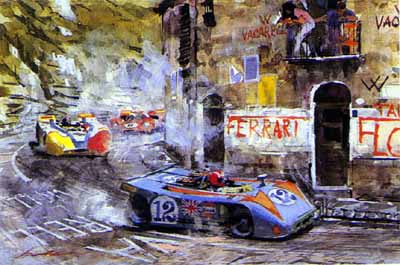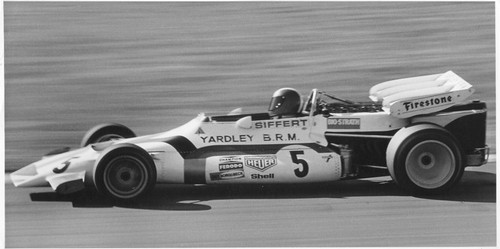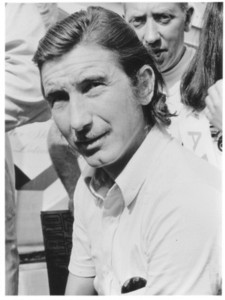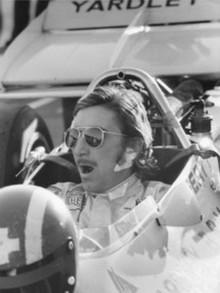He made his first Formula One appearance in 1962, driving a Lotus 24 in the Belgium GP. He joined the Swiss Ecurie Filipinetti team in 1963, driving a Lotus-BRM, however, he left the Filipinetti team during the 1964 season, after disagreements with team management. For the second half of the 1964 season, Siffert bought a Brabham-BRM, and served as owner / driver. Klaus Ewald (cited below) reports that life as a privateer was difficult for Siffert, with the team alternating between cheap hotels, farm houses near the tracks, or sleeping bags under the stars. He had success on the track, however, placing 4th in the German Grand Prix (at the Nurburgring) and then winning a non-championship race at Enna (in Sicily), defeating Jim Clark in the race. The victory at Enna marked a turning point in Siffert's career. Throughout the race, Siffert battled Jim Clark, then the world champion, in his Lotus-Climax 33, and Innes Ireland, driving a BRM, with the victory coming with a margin of 0.1 of a second. (He following year, Siffert repeated the win at Enna, this time beating Clark to the line by0.3 of a second.).
With these successes in German and Sicily, Siffert was "discovered" by Rob Walker, who teamed Siffert with the Sweed, Jo Bonnier, beginning with the United States Grand Prix, in October. Repaying Walker's confidence, Siffert achieved his first podium finish in this race, finishing behind Graham Hill and John Surtees.
For the 1965 season, Siffert continued on Walker's team, teamed with Bonnier and driving a Brabham-BRM. After several top-10 finishes, in July, Siffert again won the Mediterranean GP, at Enna, and beating Jim Clark in the process. Siffert managed a 4th place finish in the Mexican GP and a 5th place finish in South Africa, but the season was marked by mechanical failures that frustrated the drivers.
For 1966, the specification for Formula One engines increased from 1.5 to 3.0 litres, and Rob Walker purchased a Cooper-Maserati T81 for Siffert. The engine was an adaptation of a nine-year old 2.5 liter V-12 plant; the car produced good power, but it took some time to sort through the handling issues. Other Cooper-Maserati drivers were Jochen Rindt and Richie Ginther (for the factory team), Guy Ligier, as an owner/ driver, and John Surtees, after he left the Ferrari team mid-season. For the season, the Cooper-Maseratis had a total of 39 starts, one win (for Surtees), three 2nd place finishes, two 3rd place finishes, and nine additional finishes in the top six places. The car was plagued with problems for Siffert, producing nine retirements, one failure to qualify and a top finish of 4th in the United States GP.
The years 1966 and 1967 marked Siffert's transition from the world of Formula One to the world of sports car / endurance racing. In 1966, Siffert took a Porsche Carrera 6 to a 4th place finish in the 24 hours of Le Mans, with other top-six finishes at Sebring (12-hours), Monza (1000 km), Austria. In each ensuing season, his struggles in Formula One were contrasted to his great success in sports car racing, so that each year was a tale of two seasons: struggles in Formula One and success in endurance racing. For 1967, driving Porsches (with Hans Hermann) and Ferraris, Siffert finished 2nd at Spa (a track which would later be the site of some of his most notable successes), 4th at Sebring and Daytona, 5th at Le Mans and Monza and 6th in the Targa Florio.
On the Formula One side, Cooper-Maserati introduced a lightened T81B, for Rindt and Rodriguez, but Siffert was left driving an aging Cooper-Maserati T81 for the Walker team. His best performances were 4th place finishes in the French and US Grand Prixs. At the end of the season, Maserati gave up building Formula One engines; this heavy engine had been designed in 1956, and was now thoroughly outdated.
The 1968 season is well thought of as Siffert's break-through season, in both Formula One and endurance racing. He had a spectacular win in the British Grand Prix, driving Rob Walker's privately entered Lotus 49 Cosworth, with 5th and 6th place finishes in the United States and Mexico. It was in sports car racing, however, that he laid claim to the title of the best racer in the world. Siffert drove for the Porsche factory team, and won the 24 hours of Daytona, the 12 hours of Sebring, the Nurburgring 1000 km race, and the Austrian 1000 km race, driving this last event single-handedly.
The 1969 season followed a similar pattern, with Siffert having four Formula One finishes in the top five (in South Africa, Monaco, Holland and Germany), but being almost unbeatable in the sports cars. Sharing a works Porsche 908-2 with Brian Redman, Siffert won the BOAC 1000 km, the Monza, Spa and Nurburgring events, as well as a Watkins Glen 6-hour race. Teamed with Kurt Ahrens in a Porsche 917, he also won the Austrian 1000 km race. Joining a third racing series during the season, Siffert drove a Porshce 917 in eight Can-Am events, recording four finishes in the top four positions.
For 1970, Siffert joined a much-heralded new Fromula One team, driving for March (with Chris Amon also on the works team). The year started with great promise, as Jackie Stewart finished 3rd in the season opener at Kyalami and won the second race of the season, at Jarama. But as Ferrari and Lotus sorted their cars during the season, the March became less competitive and proved almost a total wash-out for Siffert, as the new car was plagued with mechanical failures. Siffert failed to score a single championship point -- recording six finishes in the 7th to 10th range, and failing to qualify or finish in an additional seven GPs.
After the disappointing season with March, Siffert signed to drive for the BRM team in 1971. After disappointing finishes through the first half of the season, Siffert finished 6th in Holland, 4th in France, 9th in the British GP (at Brands Hatch), and then led the Austrian Grand Prix from start to finish to record his second Formula One victory. Ninth place finishes at Monza and Mosport were followed by a 2nd place finish at the United States GP, in Watkins Glen. Where he failed to record a single championship point during the 1970 season, he finished tied for 4th (with Jacky Ickx) in the final standings for 1971.
Once again, in 1971 Siffert had remarkable success in the endurance and Can-Am races. He opened the season with a win at Buenos Aires (driving with his new partner, Derek Bell) and finished well at Sebring (5th), Brands Hatch (3rd), Monza (2nd), Spa (2nd), Nurburgring (2nd), Vallelunga (2nd) and Watkins Glen (2nd). Across the Atlantic, racing in the Can-Am series, Siffert entered seven races in the Porsche 917-10 and had finishes ranging from 2nd to 5th in each of these races. After a 5th place finish in the Can-Am race at Leguna Seca, his season should have been finished.
Just as the 1970 Formula One season ended in tragedy, with Jochen Rindt winning the World Championship posthoumously, the 1971 season finished with the tragedy of Jo Siffert's death in its final race. Earlier in the season, the Mexican Grand Prix had been cancelled, because of safety concerns at the track. As a substitute for the Mexican GP, a non-championship Formula One races was held at Brands Hatch, on October 24, 1971. It was expected that the Brands Hatch race (called the "Rothmans World Championship Victory Race") would be a celebration of a great season, in which British hero Jackie Stewart had dominated the point standings. Stewart won six of 11 races, with his 62 championship points almost doubling the 33 points of Ronnie Peterson. Celebration turned to tragedy on the 15th lap, when Sifferts's BRM P160 went off the track at Hawthorn Hill, the fastest section of the circuit. The precise cause of the accident has never baan made poublic, but the car hit an earth bank and erupted into flames. Siffert died of asphyxia in the cockpit, having suffered only a broken leg as a result of the impact.
[to be added]
In 1971, Jo Siffert was driving for BRM, in a car sponsored by Yardley. Sue Lehmann was employed by Yardley, running one of their top cosmetic accounts during the week and the promotion team at the Formula One races on the weekends. In the July 1971, Siffert drove in the British Grand Prix, at Silverstone, finishing 9th. Here are some photos taken of Jo Siffert and Sue Lehmann during the Silverstone weekend.
As described above, on October 24, 1971, Jo Siffert participated in a non-championship held at Brands Hatch, the Rothmans World Championship Victory Race. Prior to the race, Sue had Siffert autograph the photographs from the Silverstone weekend, and she wished him well as he pulled away from the pits to start the race.
All photographs in this section, and several others taken by Sue Lehmann, are available through the
Sue Lehmann Section
of the Passing Shots Motorsports Photography website.
For a well-written article about Jo Siffert, as a person and as a racercar driver, see
The Man from Fribourg -- The Jo Siffert Story, which appears on the very interesting Research Racing website. This article has details of the race in which Siffert was killed, at Brands Hatch.
|
 Once again, Siffert met with far greater success in the world of sports cars. He won the Targa Florio, driving a Porsche 908-3 with Redman, and the Spa 1000 km, also with Redman, and had 2nd or 3rd place finishes at Daytona, Watkins Glen, Jarama and Kyalami, all in Porsches.
Once again, Siffert met with far greater success in the world of sports cars. He won the Targa Florio, driving a Porsche 908-3 with Redman, and the Spa 1000 km, also with Redman, and had 2nd or 3rd place finishes at Daytona, Watkins Glen, Jarama and Kyalami, all in Porsches.





